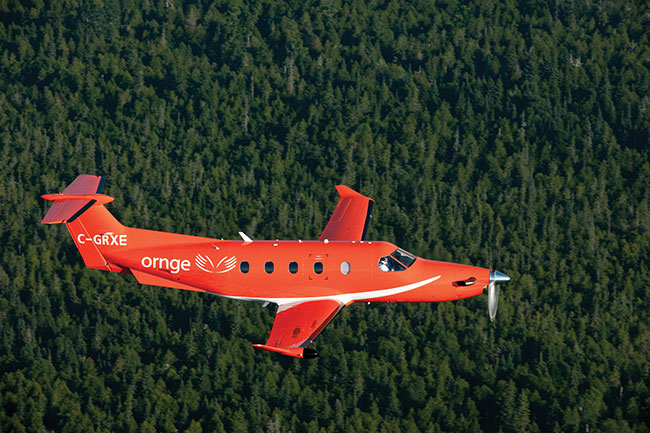
Features
Emergency Services
Public Safety
Inside Ornge
Ontario commits to expanding Ornge’s Pilatus fleet to provide greater health equity in the north
February 7, 2024 By Jon Robinson
 Ornge’s primary mission is to serve more than 14.5 million Ontarians in an area spanning more than one million square kilometres. (Photo: Ornge)
Ornge’s primary mission is to serve more than 14.5 million Ontarians in an area spanning more than one million square kilometres. (Photo: Ornge) It is not until you drive or fly around at least part of Lake Superior, starting from somewhere in the population-rich southern infrastructure of the province, that you can truly appreciate the vastness of Ontario. Canada’s third largest province by landmass after Quebec and British Columbia, Ontario holds a population of more than 14.5 million people spread out over approximately one million square kilometres.
The Government of Ontario in November 2023 recognized the critical role Ornge plays in its health care system by confirming plans to expand its fixed-wing fleet with four additional Pilatus PC-12 NGX airplanes, in addition to a prior commitment to replace eight PC-12 NGs with the new, more fuel efficient NGX variant. The plan was first outlined in December 2022 with the goal of increasing Ornge’s ability to connect people in northern, remote and Indigenous communities to timely access of emergency care.
More than $108 million will be invested over the next few years to modernize Ornge’s fixed-wing fleet to provide Ontarians with safe and reliable air transport as part of their health care system. The provincial government is also providing nearly $10 million to transition Ornge’s Sudbury base to a larger hangar, which will be able to house both fixed-wing and rotary-wing assets.
Together with 13 Crestline Commander land ambulances, Ornge also operates 12 Leonardo AW139 helicopters. It is the fixed-wing fleet, however, that primarily serves the remote northern communities in the fight to provide health equity for Ontarians. Once the new 12-plane fleet starts to arrive in 2026, Ornge will be able to add two fully staffed, 24/7 air ambulance crews to further connect people in the region.
Health equity is a primary mandate of Ornge as its leadership envisions how they can play a larger role than that of a traditional air ambulance provider. This vision was reinforced and expanded during the COVID-19 pandemic.
“The distances involved are large. And so, you cannot talk about access to health care without fixed-wing transport,” says Dr. Homer Tien, President and CEO of Ornge. “It’s the only real meaningful way to improve access to care right now in these northern communities.”
Tien joined Ornge as Chief Medical Officer in 2015 by way of the Canadian military and as the Medical Director of the Tory Regional Trauma Centre at Sunnybrook Health Sciences Centre. He became CEO of Ornge in January 2020 just prior to the pandemic and, in April 2021, Tien was appointed to head Ontario’s COVID-19 Vaccine Distribution Task Force for Phase 2 of the rollout. Tien witnessed firsthand the importance and capability for Ornge to be more than a traditional air ambulance provider. He is passionate about providing health equity to people in northern Ontario and works closely with Indigenous communities across the province.
“We helped with the remote Indigenous vaccination program during COVID. We were responsible for what was called Operation Remote Immunity,” says Tien. “[The government] saw that if you have skilled health care providers like we do in our critical care paramedics, and fixed-wing aircraft, you can really improve access to health care, whether it be for emergencies or preventative like COVID vaccines.”
Tien explains Ornge is pleased with the state of its mid-life helicopter fleet, which began to receive an updated livery in 2021. The same design will be applied to Ornge’s new fixed-wing aircraft starting in 2026 with Pilatus deliveries scheduled to continue until 2030. By that time, Ornge is likely to have significantly grown its already prime position in Ontario’s health care system.

A rendering of the new fixed-wing livery that will adorn Ornge’s upgraded fleet of Pilatus PC-12 NGX aircraft, scheduled to start arriving in 2026. (Image: Ornge)
“The classic air ambulance [model] is a restricted role. Our involvement in the pandemic really showed us how healthcare is siloed,” says Tien, describing how Ornge’s work during the pandemic stretched into a new level of providing health care. One of the main challenges faced by the Ornge team during the pandemic came from local surges for health care needs. There was enough capacity in the system, explains Tien, but it meant that Ornge was transporting patients to where the capacity was.
“As the health care system evolves and there are more and more challenges, I think you’re going to need to see that integrator in the system playing a bigger role; and I think that’s us,” says Tien. “Transport obviously will play a huge role, but there’s going to be other things that come up that aren’t just about access to care. We will have a role because we have vehicles, we have airplanes, we have helicopters, we have skilled personnel, and we have a communications centre.
“There are very strong hospitals that represent local and regional [interests], Centres of Excellence for care, but all of that space in between needs filling,” Tien continues, describing rights of access to services like MRI and CT Scans for remote communities, in addition to the emergency response Ornge is best known for. “That is what we provide: Access to care and health equity.”
The air transport distances involved are one of the primary reasons why Ornge and Ontario agreed to terms around acquiring a new fixed-wing fleet, as opposed to initiating a mid-life extension program. Neither Ornge nor the government’s health care assets can afford to be down for maintenance. “The distances for these trips are thousands of kilometers, 1,700 on average for one patient transport, in terms of a round trip and to get back to base,” says Tien. “With the type of distance that we travel, you can only do a few transports in a day during a shift.”
Another primary aircraft requirement for Ornge to reach its missions objectives is capability to access 3,500-foot gravel runways, on average, which greatly limits the aircraft manufacturers who can submit an RFP for such a fleet renewal program. Then, add in the need for an aircraft to offer an extra-large cargo door to load patients, but at the same time hold a relatively short wingspan to fit into existing well-equipped hangars. Just as with the arrival of its first Pilatus aircraft, the newest Pilatus workhorse fits the bill in many ways, not to mention the extensive existing PC-12 infrastructure in Canada, overseen by Levaero Aviation, with more than 100 variations of the type operating here to provide access to flying and maintenance expertise.
“We base our mission profile on distances,” explains Peter Cunnington, Chief Aviation Officer, Ornge. “For the in-tight [calls], we’re using land vehicles for the provision of critical care and then the helicopters go out to about the 135-nautical-mile range and beyond that is fixed-wing, which is the north. Of the approximately 21,000 patient-related transports we coordinate a year, nearly 50 per cent of those transports are fixed-wing.”
Ornge’s mission in the north currently focuses on what Tien outlines as intraregional transport, which involves breaking northern Ontario into two regions with northwest coverage situated around its Thunder Bay base, with a forward base in Sioux Lookout and stretching up to Fort Severn, and northeast coverage from a collection of smaller bases in Sudbury, Timmins and up to Hudson Bay at Moosonee.

Ornge started upating the livery of its Leonardo AW139 helicopter fleet in 2021. (Photo: Ornge)
“From a health equity perspective, we wanted to see some equality between northeast and northwest Ontario; and Sudbury is an ideal location, because like Thunder Bay where we have a 24/7 helicopter, we already have that in Sudbury. We just didn’t have a facility big enough to house at all,” says Cunnington. “We know that our call volume is going to increase. We are forecasting an approximate 16 per cent increase over the next 20 years.” The base expansion in Sudbury will serve as a vital part of Ornge’s vision to provide greater health equity across Ontario.
“When it’s busy in the northeast, we have to respond from Thunder Bay, which is an extraordinary distance,” says Tien, describing Health Sciences North in Sudbury as a major receiving area. The expanded Ornge base in Sudbury will balance out provincial coverage and provide more timely response to the James Bay and Hudson Bay region where more than 15,000 people live. Bringing in the more fuel-efficient Pilatus PC-12 NGX, with predictive health monitoring and a raft of modern avionics, will be a clear opportunity to help Ornge provide Ontario with more health equity. “The major thing for us is the calculation of weight and balance that allows us to do the mission profiles we’re looking at,” says Tien, who notes plans for the new aircraft include lightweight aluminum racking, for example, as opposed to cabinets used in the current fleet. He explains not only might Ornge be needed to transport bariatric patients, over distance, but also to fly a family member escort, which Tien sees as key pieces in health equity.
Cunnington explains Ornge is working closely with Pilatus to determine a optimal operating weight for the new fleet. “We are undertaking a very significant exercise, building scenarios, and looking at all the possible combinations,” he says.
Tien explains Ornge, particularly with the pending arrival of its new fleet, needs people with technical competency in areas like fixed-wing pilots, rotary-wing pilots and paramedics, in addition to appreciating what Ornge represents for Ontario and the country. Ornge currently holds around 700 employees and during the pandemic its leadership saw how well their team understands the mission. “Ornge really stepped up… We had people signing up for extra shifts to transport patients to where the capacity was. We had people signing up to go to remote Indigenous communities to lead vaccination teams,” Tien says, “It’s the mindset of believing in the importance of what we do and then applying your technical expertise to get that mission done.”